Description

Wedding Photography Services in Istanbul
Istanbul is one of the center point in Europe for weddings ; The beautiful weather and nice scenecs and panaromic views, attaract couples to get married in istanbul .
With our experienced – professional photographers and equipments, we provide indoor and outdoor wedding photograpy and video services with our english speaking team. For any requests, please send us an E-mail.
Here you can see our packages ;
Eco Package – Outdoor Photo Shootings
Includes bride and groom outdoor photo shoots in İstanbul.
According to your inquiries and our suggestions with different concepts, we will make 3-4 hours of photo shoot.
All Equipments, accessories and professional photography service is included in the price.
It will include app. 300 – 400 photos.
In the end of the photo shooting, we will provide a DVD of the photos in high quality.
Bronze Package – Outdoor Photo Shooting
Includes bride and groom outdoor photo shoots in İstanbul. According to your inquiries and our
suggestions with different concepts, we will make total 4-5 hours of photo shoot.
It will include app. 300 – 400 photos.
All the photos will be re-touched and edited in photoshop and will provide them to you in DVD in high quality.
We will choose 25 photos, apply detailed photoshop and make a spacial digital album.
We will choose 25 edited photos and make a Music Video Album in DVD format.
Silver Package – Outdoor Photo Shooting + Photo Printing
Includes bride and groom outdoor photo shoots in İstanbul. According to your inquiries and our
suggestions with different concepts, we will make total 4-5 hours of photo shoot.
It will include app. 300 – 400 photos.
All the photos will be re-touched and edited in photoshop and will provide them to you in DVD in high quality.
We will choose 25 photos, apply detailed photoshop and make a spacial digital album.
We will choose 25 edited photos and make a Music Video Album in DVD format.
1 Panaromic Printed Album and 2 Regular Album and 1 50 x 70 Cm Poster Photo will be made.
Gold Package – All Day Indoor & Outdoor Photo Shooting + Photo Printing + Wedding Evening Photography
Includes wedding preparation ( Hair Dressers and preparation etc. ) bride and groom outdoor photo shoots.
According to your inquiries and our suggestions with different concepts, we will make total 5-6 hours of photo shoot in the day and all the wedding evening until the end of the wedding night.
It will include app. 300 – 400 photos for the day & 400 – 500 photo for the wedding evening.
All the photos will be re-touched and edited in photoshop and will provide them to you in DVD in high quality.
We will choose 50 photos, apply detailed photoshop and make a spacial digital album.
We will choose 50 edited photos and make a Music Video Album in DVD format.
1 Panaromic Printed Album and 2 Regular Album and 1 50 x 70 Cm Poster Photo will be made.
Professional wedding evening photography with our team in the venue.
Please ask us if you are interested in video shootings.
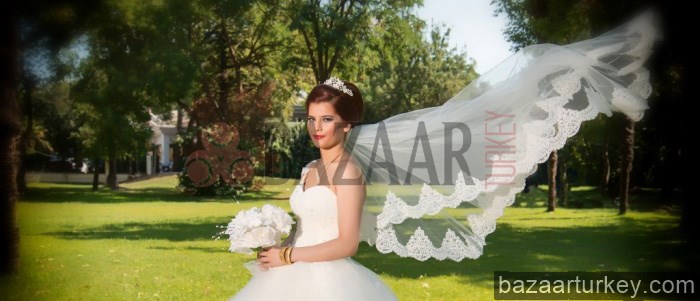
Wedding Photography Service in Istanbul
Eco Package: 590 Euro
Bronze Package : 720 Euro
Silver Package :900 Euro
Gold Package : 2300 Euro
Half Day VIP Minivan Rental : 120 Euro
Full Day VIP Minivan Rental : 180 Euro
Full Day & Wedding Evening VIP Minivan Rental :280 Euro
Service Includes.
** Professional Photography.
** English Guidance Service
** Services Mentioned Above.
** Private Mercedes Vito Luxury Car Service .
Bazaar Turkey – Les Arts Turcs Art Studio
Alemdar Mh. Incili Cavus St.
No: 19 Floor : 3 (Behind The Underground Cistern)
Sultanahmet 34110
Istanbul, Turkey
Contact : Mr. Alp or Mr. Nurdogan ( Phone : +90 544 220 10 22 )
E-mail : info@bazaarturkey.com
Google Maps : https://goo.gl/maps/uXuyRmELZsx
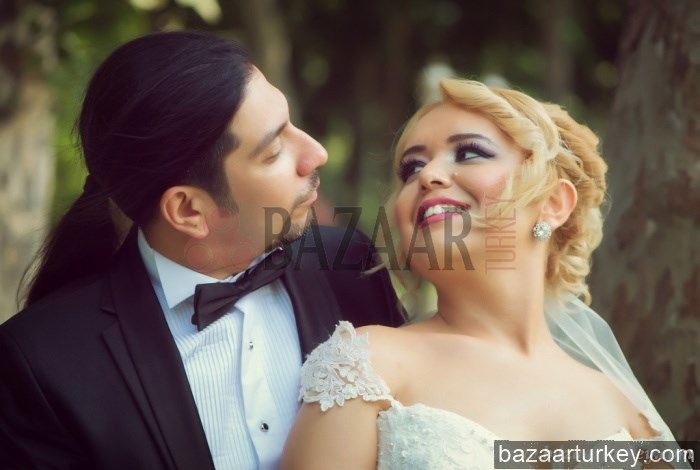
Wedding Traditions in Istanbul – Turkey
Marriage
Marriage is an association that existed since the earliest times and has great importance on human life and society. Marriage as a term is a continuous union of a man and a woman as husband and wife under all kinds of conditions of life. It is the foundation of the family which in turn is the cornerstone of society and carries universal importance. The marriage act has certain rules and patterns that change around the world, shaped by different cultures and entailing traditions and customs that define a particular society.
Marriage ceremonies incorporate a number of preparations and phases leading up to the actual act. These stages include religious and even superstitious practices. At each phase, the implementation of a variety of common practices, customs and traditions have become obligatory, almost like rules and principles that govern this ritual act. Each and every society, in compliance with certain rules and practices conforming to their culture, has developed its own particular ways of executing this event. Here we will try to elaborate on different phases of marriage, complete with distinct and rich customs in every region, province and even village in Turkey, by making an attempt to generalize them along main features and aspects.
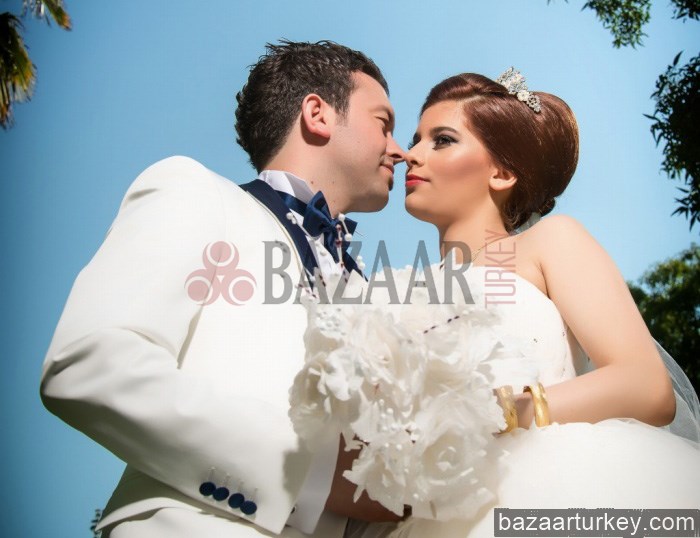
Different kinds of Marriage:
In the past, marriage among relatives, such as cousins, was common in Turkey. Today such kind of marriage is not practiced that much any more due to impact of urbanization.
Another kind of marriage is that in the case of death of a brother, where the widowed sister-in law is wed with a single or widower brother-in law (Levirat). This is done in order to keep the inheritance of the deceased in the family and for the children’s welfare. Similarly, it is also possible that a sister gets married to a deceased sister’s husband (Sororat). However, this rural tradition too is disappearing fast.
Another type of marriage is “taygeldi” marriage. In this marriage, the children from previous marriages of a widow and widower, who get married, may get married as well.
In the past, particularly in rural areas, men would “snatch” or kidnap a girl that they wanted to marry, but were not allowed to for one reason or the other, mostly due to objection by families. It also happened that a girl and boy run away in mutual agreement to overcome family objection to their matrimony. In some regions, there is also a type of “snatching” called “oturakalma”, where a girl goes to the home of the man that she loves and settles there, many times at the objection of her own family.
Another type of marriage which was often practiced in the past is “besikkertmesi”. While children were yet in their cradle, they were promised or “engaged” to each other by their families. In the past, the rejection of marriage by the girl or boy once they reach marrying age, would be regarded as dishonor to the family and even could cause bloody family feuds. This type of arranged marriage is almost extinct today.
Another kind of marriage arrangement or custom in Turkey is marriage of “ic guveysi”. In this marriage, a man settles in the home where his wife lives. Usually in case of inability to pay a dowry for the bride or the absence of a son on the part of the bride’s family leads to this kind of arrangement.
In another type of marriage called “Berder” ( exchange, changing) two families may marry their daughter and son to another family’s son and daughter. Such kind of marriages releases the two families of an old custom to pay a dowry to the bride’s family, since they “even” out.
A note on Baslik – dowry – is in place. This is an old custom that has nearly ceased to exist in the vast majority of Turkish society and is confined only to very underdeveloped regions.
According to Turkish traditions marriage between “milk” siblings is not possible. Children who are breastfed by a woman (a custom that was not uncommon in Turkey, when a mother could not breastfeed due to illness or other reasons, especially in rural areas, but has nearly ceased today) other than their mother become her “milk” children and they are not supposed to marry their “milk” siblings.
In some regions marriage with more than one wife at the same time (polygamy), while outlawed and punishable by law, is still practiced and it was more prevalent in the past when a wife could not bear children or she became ill or invalid.
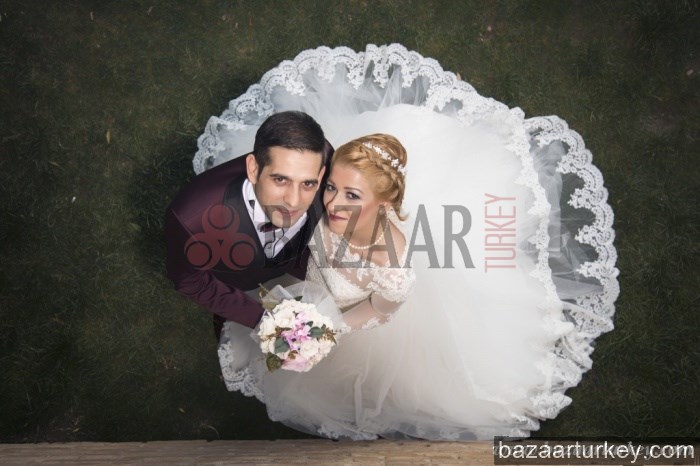
Age of Marriage:
There is wide variation in marriage age today, with lower limits set by law. Today, men usually are expected to marry after they complete their mandatory military service, in some more traditional areas right before. General marriage ages are around 22 for men and around 20 for women, with 5-6 years variation upward. Today, more youngsters go to college, which pushes up their marriage age mostly until after graduation. Older siblings are usually expected to get married before younger siblings, particularly if they are of the same gender. Pressures to marry at a younger Although age of marriage varies according to regions today in areas where traditions are observed.
In the general procedures of marriage, the groom to be and this family usually take the lead in initiating the steps leading up to marriage, while the courted girl’s family remains passive. The first step toward marriage is expected of the man and his family.
Act of go-between (Görücülük), To Ask a Girl’s Hand in Marriage:
In the traditional setting, the courtship process leading up to a marriage begins with seeing and looking for a girl. Families who want to marry their sons begin looking out for girls, starting with their relatives, neighbours and close friends. They get willing assistance in this “search” from their relatives, neighbours and friends.
In larger cities of Turkey, where cultural changes have been more rapid, it is now most common that people meet up personally and develop a relationship directly. However, “Görücülük” has been still the main type of interaction enabling marriages is more traditional communities and rural areas. “Görücülük” is the act of go-between of several women of a family or friends of a man who wants to get married, who pay special visit to the home of the girl who they see as a potential fit to the man, to examine the girl closely and reveal their intentions. This procedure is called “seeing a girl, to send women to see a girl, woman sent out to inquire about a prospective bride” (“kız bakma”, “görücü çıkma”, “dünür gezme” in Turkish). After their affirmative judgment about the girl, time is granted to the prospective bride’s family both to get more information about the prospective groom and his family and to make a decision. As the result of affirmative agreement by both families to pursue this first acquaintance further, the task of the go-betweeners (gorucus) comes to end. Inasmuch as the fact that the work of seeing prospective bride is done by women, they do remain engaged in the process of asking for the girl’s hand.
In the process of asking for the girl’s hand in marriage, care is taken to include among those who will visit the prospective bride’s family such respectful persons who could not be refused by the bride’s family, together with close relatives of the prospective bridegroom’s family. It is not uncommon that several such visits are paid to a family or girl who’s reluctant to agree to this marriage for one reason or the other.
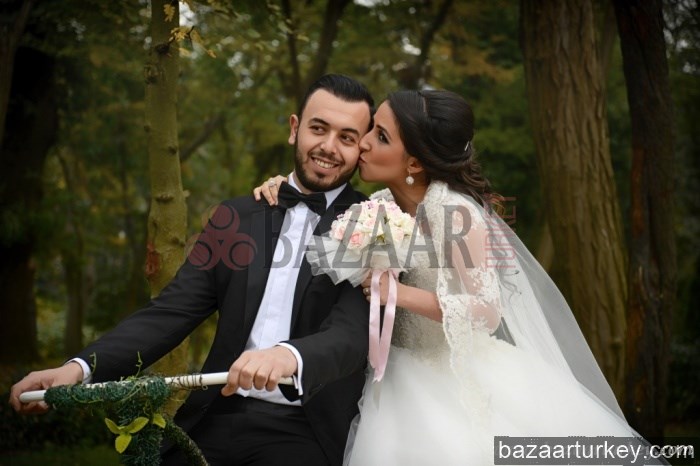
Agreement to Marry:
Agreement to marry (söz kesimi) follows the process of asking the prospective bride’s hand in marriage. Both families who reached an agreement by way of “Dünürcülük” (women sent out to inquire about a prospective bride) agree on marriage before crowded guests, which is called “Söz Kesme” (agreement to marry). Engagement is completed by attaching a ring and an embroidered kerchief bought by the prospective bridegroom’s family. In some regions “Söz kesimi” is also called small engagement ceremony. Sweet dessert (aÄ¿ız tatlılıÄ¿ı) brought by prospective bridegroom’s family is distributed to guests immediately after agreement by both parties to marry their children. Even today in some regions the prospective bridegroom is not present at the time of this ceremony. According to the attitude of the prospective bride’s father the bridegroom who is present in the bride’s home and the prospective bride both kiss the hands of the elder guests. Thus, the ceremony held for agreement to marry is completed.
Engagement
The step after the ceremony for agreement to marry is engagement. The engagement ceremony is held in the bride’s home and the costs of the ceremony in some regions are borne by the bridegroom’s family, but many times by the bride’s family.
After designating the date for engagement ceremony an invitation called “invitation to neighbors” is made. Guests who gather together on the day of engagement in the bridegroom’s home go to the bride’s home. In the traditional sections of the community, women and men sit separated in the bride’s home, and after having lunch, jewelry called “takı” is given to the bride who is dressed in special engagement dress given to her by her mother-in law and relatives of the bridegroom. In some areas the bridegroom does not come to the bride’s home. In this case engagement ring is worn by the bride via a woman coming from the bridegroom’s home. In an engagement ceremony where the bridegroom is present rings worn by the bride and bridegroom are placed by an old man on ring fingers of their right hand with accompaniment of standard words and wishes.
In many engagement ceremonies today, the ceremonies become more elaborate and modern, where wedding halls are rented and men and women sit together, music, mostly live, is played and the engagement is celebrated by family and friends of the prospective bride and groom.
No definite rule is imposed for the length of the engagement. Rather it depends upon agreement by both sides. While it is considered natural that engaged couples may meet each other in more modern communities, in traditional, rural communities, such meetings are allowed only through the permission of the parents and usually a family members accompanies the couple. Breaking off an engagement is considered a serious matter and is frowned upon in traditional circles. If the party who broke off the engagement is the girl, all jewelry that she received must be returned to the former fiancé. If the man broke off the engagement, usually his former fiancée keeps the presents.

Wedding:
Let’s note at the onset that the following information on wedding ceremonies pertains to older, rural and conservative traditions in Turkey. Weddings today in the cities and more modern circles are much more like western style weddings, with a wedding banquet or reception uniting family and friends of the couple. Also, all marriages require a civil ceremony conducted and recorded by a municipal officer to become legally effective. In many cases, the religious ceremony precedes the civil ceremony by a few days.
In the traditional setting, wedding ceremonies generally start on Tuesday and end on Thursday, or start on Friday and end on Sunday. Wedding expenses are met by the bridegroom’s family. Regional variances aside, traditional weddings are marked by the following passages: Planting of a wedding flag, an entertaining gathering for the women of the couple’s families on the night before the wedding day, characterized by the coloring of parts of the hands and feet with Henna (Kına Gecesi), fetching the bride, and the bride’s veil.
Before the wedding, as is done in the course of the engagement ceremony, formal invitations are distributed and family, friends and neighbors are invited to the wedding. While the bride’s family tries to complete preparations for the trousseau, the bridegroom’s family tries to complete gifts for the bride to be presented to her before, during and after the wedding.
A wedding flag is planted by men coming from the noon prayer and friends of bridegroom at the bridegroom’s home. In some regions, apples, onions, mirrors, etc. are placed on top of the flag. Thus the wedding is officially underway.
Kına Gecesi:
A traditional version and perhaps precursor of the bachelorette party, the night before the wedding is set aside for the bride to spent her last night at her family’s home in the company of women of all ages who are close to the couple’s family. This ceremony get its name “Kına Gecesi” – Henna Night – from the fact that the usually the hands of the bride is adorned with Henna. The bridegroom’s female relatives too attend this event and are hosted in the bride’s home.
Henna Events in Istanbul ;
Traditional Turkish and Indian Style Henna Tattoo In Istanbul – Bazaar Turkey
Usually dry henna brought by the bridegroom’s family is broken to pieces in a silver or cupper vessel by a woman whose father and mother is still alive, and not experienced otherwise separation. After preparing the bride, a veil ornamented with red flake is placed over her head, and she is brought amidst the guests accompanied by songs and hymns about henna. Hands and feet of the bride are dyed with henna. The bridegroom’s side is under the obligation to put money in the hand of the bride. Dying ceremony of henna is different according to regions. The henna so dyed has such names and types as “iplik kınası” (henna for yarn), “sıvama” (smearing), “kusgozu” (bird eye). This ceremony, which itself can be a sad occasion, where relatives of the bride, particularly her mother lament the departure of the daughter from her parent’s home, is followed by joyous celebration, song and dance. After the guests leave, it is not unusual for the closest friends of the bride to remain with her until the next morning, spending their last “single” hours together. In some regions, a similar ceremony is held for the bridegroom by his friends at his home.

Feching the Bride (Gelin Alma):
The next day is the day of “Gelin Alma” (to fetch the bride), “kız alma” (to fetch girl), “gelin götürme” (to carry the bride), etc. Everybody is invited to this ceremonial procession from the home of the bride to the home of the groom. Guests go to fetch the bride on foot if not far, or by cars if too far to go. In some regions the bridegroom has not been allowed to accompany the bridal procession. The procession is followed by drums and pipes. In some regions the bride is prepared by elderly women (yenge) who help and attend to the bride. But generally today the preparations for the bride are done at a beauty salon. Then she joins the procession on her way to the groom’s home. Before leaving her home, a “Maidenhood Belt” (Bekaret kuÅ¿aÄ¿ı), mostly a red ribbon, is tied around the Bride’s waist by her brother or a close relative and then the bride says good-by to those who stay at home. To lighten things up, the doorway is sometimes blocked by a male relative of the bride or a younger brother sits on the wooden chest that carries the bride’s dowry, as to not allowing the bride to leave. A tip by the groom’s family solves this final hurdle, and the bride leaves her parent’s home.
After traveling around the village, accompanied by drums and pipes, the wedding procession arrives at the home of the groom. The bride and procession is met by the Mother-in law at the front door, who welcomes the bride with a gift. Then the groom takes her by the arm and leads her inside the house. After a while the groom is taken out by his friends until later in the night. While away, he is shaved, bathed and dressed and taken to the mosque for the late night prayer (Yatsı Namazı) and then he is returned home. The religious marriage ceremony is performed for the bride and the groom who had returned to home accompanied by the hodja (preacher) of the local mosque. After the ceremony is performed, the bride and groom are allowed to enter the nuptial chamber.
HENNA PARTY
In former times, wedding festivities were drawn-out affairs lasting several days. They began on a Monday with the dispatch of the bridal trousseau to the bridegroom’s house. The procession carrying the trousseau was proceeded by large wooden or iron “trees” decorated with cloths, fruits, and flowers. The bridal bath was held the following day (Tuesday) while Wednesday evening was when a henna~party was held in the harem section of the house in which the bride-to-be lived. At the same time, the menfolk would be enjoying themselves in the men’s quarters (selamlık) of same house or in that of the groom’s.
A henna party was an occasion on which the bride, young girls, and the womenfolk of her future husband dressed up in the sumptuous, heavilyembroidered dresses called bindalli. The bride’s face would be concealed by a sequined red veil. The henna for the party would be brought to the bride’s house on a silver tray with two burning candles by a few of the groom’s relatives. After all the guests were assembled, the bride’s future mother-in-law would roll out like a carpet before her a bolt of silk cloth that she had brought with her as a gift. The bride and her friends, carrying lit candles, would approach the guests while coins would be scattered over the bride’s head as symbols of fertility. The bride would walk along the unrolled bolt of silk cloth towards her future mother-in-law (this often was the first occasion on which they met), take the woman’s hand, and kiss it respectfully. Trays of fruits and nuts, pastries, and marzipan would now appear. Songs and ditties reserved only for henna-parties would now be sung in an attempt to make the prospective bride cry. (Her crying was believed to bring good luck.) Next the bride would be made to sit on a cushion and her mother-in-law would place a gold coin in the palm of her hand. This gold coin was believed to be a symbol of good luck and abundance. Now a woman who was known to have a happy marriage had the job of tinging the palms, fingertips, and big toes of the bride with henna. The bride’s unmarried friends would also tinge their hands with henna in the belief that this would enable them to get married soon.
Henna Events in Istanbul ;
Traditional Turkish and Indian Style Henna Tattoo In Istanbul – Bazaar Turkey
Fetching the Bride
On the wedding day, the bride has to depart the family home for the last time, which is quite a ceremony itself. After having her hair and make up done in a beauty salon, the bride comes back home to wait for the groom’s family to fetch her, all dressed up in her wedding gown. Typically, the family of the groom and all the relatives along with friends gather at a determined spot to form a wedding procession (alay) with their cars. The destination is naturally the bride’s home. All the cars attending the procession are given embroidered towels by the family of the groom and the towels are tied to the rear-view mirrors and they move towards the bride’s home to fetch the bride. Typically, the wedding procession is lead by a pick-up full of musicians playing live and a cameraman recording everything. When they reach the bride’s home, music continues and people dance on the street until the bride comes out.
Meanwhile, the bride bids farewell to the family members one by one and a red maidenhood belt is tied around the waist of the bride before she moves out for the last time. After that, the groom himself or the groom’s family (regional variations) comes to fetch the bride, during the process of which they may encounter one last hurdle. One thing to note here, the bride usually writes the name of her single relatives and friends under her shoe with the hope that the name to be wiped off of the shoe first will be the one to get married next. This last hurdle is typically a young boy waiting at the bride’s door holding a Turkish flag, saying “The door won’t open“.
By now you must have understood that if someone says a particular thing doesn’t work, the only way to make it work is to tip the person saying that. So the flag-holder is given some money to move away, and the couple comes out of the home accompanied by prayers and music. It is very common to observe the bride’s family crying in this phase, since the whole procedure symbolizes the final departure of the bride from her family’s home to start her own life. The couple then goes to the groom’s home for the religious marriage procedures led by an imam (see the beginning of this article for the details). Also, the groom’s family is responsible to feed the guests stopping by in this phase.

The Wedding,
Finally! As a matter of fact, a well-organized wedding ceremony is the easiest phase among all those I have mentioned. The wedding procession simply leaves the home of the groom after the religious wedding ceremony, and go to the wedding hall that was rented months ago. In the hall, everything from the chairs to the walls are ornamented in various sorts. Turkish Wedding Traditions – Wedding Hall Everybody arrives in the wedding hall while the bride and the groom wait for the last preparations to be completed in a room that is typically backstage. In most cases, there is live music in the wedding hall and the head musician also acts as the presenter. When everything is ready, the musician welcomes the guests and announces the names of the bride and the groom to come. Accompanied by music, the couple steps into the middle of the dance floor followed by a huge applause.
If the couple has not completed the legal part of marriage yet, a registrar is also present at the scene to ask for the approval of the couple for their legal marriage. Both the bride and the groom have to give their approval out loud in order for the marriage to take place legally. Two or more witnesses have to be there in the scene and they also sign the legal documents after the couples. The last step before everybody starts dancing all evening long is the presentation of gifts. Typically, everyone who comes to the wedding hall gives gifts to the couple in the form of golden accessories and cash. The closer the guest is, the more valuable the gifts become. They can be varying from a golden bracelet to a golden coin.
The completion of the gifts ceremony means that the difficult parts are all completed, and the rest of the night is all about dancing, eating, drinking and feasting. At the end of the wedding party, after everybody leaves, the bride bids farewell to her family one last time and the couple usually leaves for their own home or their honeymoon.

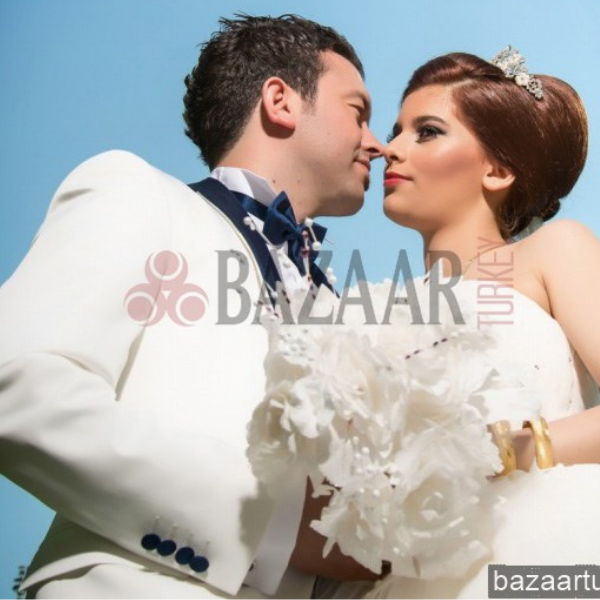

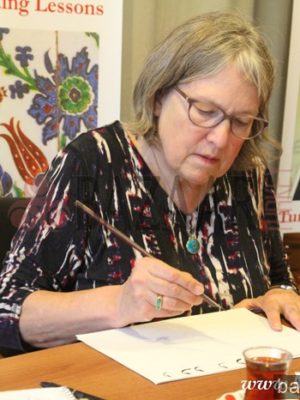

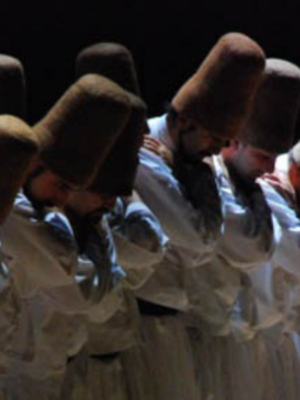



Reviews
There are no reviews yet.